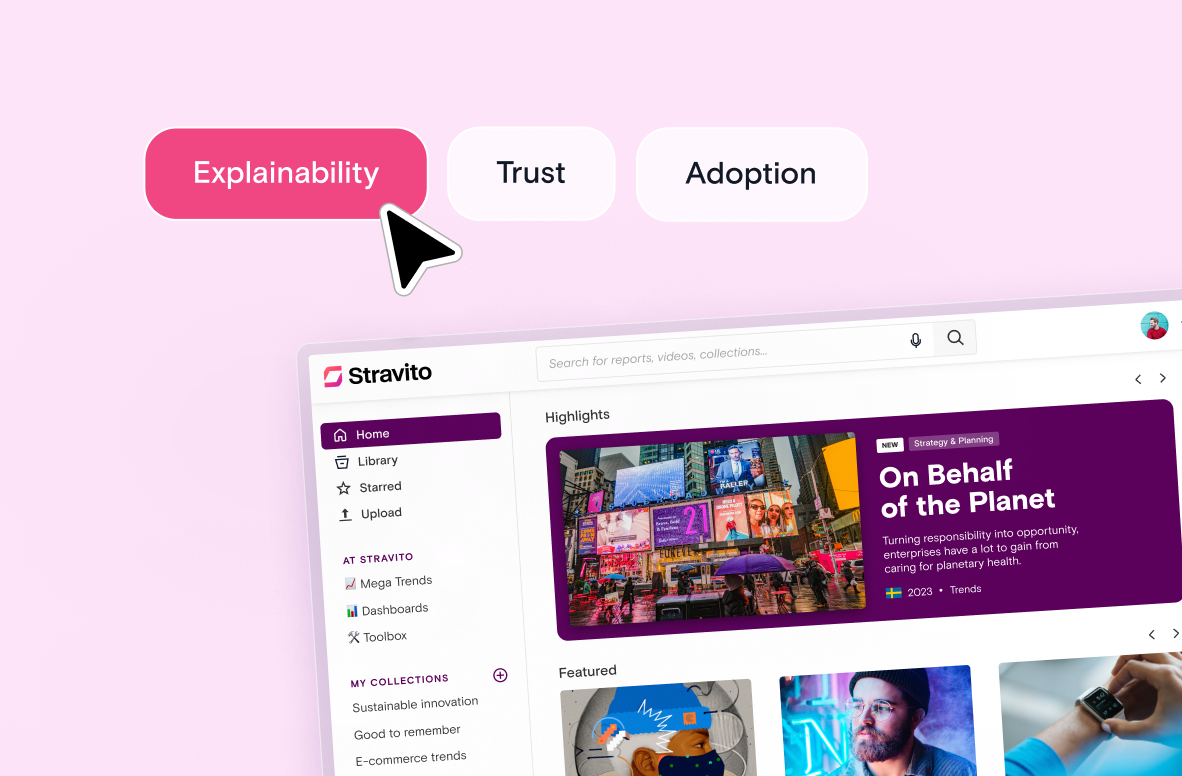Almost half of the poll respondents in a recent webinar said that less than 40% of their colleagues — who could benefit from UX research — even know it exists. And that stat might be generous.
Why? Because most UX researchers are still focused on design and product teams, overlooking the wider business context.
The truth is, UX research only changes outcomes if people see it, understand it, and use it. Yet, in many organizations, valuable research sits hidden in folders, or trapped in tools that only a few teams access. Major business decisions are made without the full picture. Strategic opportunities get missed.
That’s where research socialization comes in.
In this guide, we’ll show you six effective ways to raise awareness, increase visibility, and democratize access to UX research across your organization — with help from a modern research repository like Stravito.
Why UX research socialization matters
The stakes are high. UX research done in isolation has limited value. It’s not enough to conduct the work — you need to connect research insights to business impact.
Here are a few key reasons why socializing your research is essential:
- Research without visibility has a limited impact: Even your best insights won’t make a difference if nobody sees them. When research findings don’t reach key stakeholders, teams end up guessing instead of deciding based on real user behavior and evidence.
- Visibility earns recognition (and budget): The more accessible your UX research is, the more likely decision-makers are to value it. When leaders can clearly see how your work informs product development and supports strategic planning, it’s easier to secure buy-in, resources, and headcount.
- Socialization improves understanding: Not every team member is fluent in research terminology — nor should they be. Socializing research in clear, user-friendly formats helps more people engage with your work and brings user-centered design into every corner of the business.
6 proven ways to socialize UX research insights
Now that we’ve covered why research visibility matters, let’s get practical about how to make it happen.
Socializing UX research is about more than sharing findings — it’s about embedding user research insights into your organizational culture, influencing multiple stakeholders, and creating a repeatable research process that supports decision-making across departments.
These six actionable strategies help UX researchers, product managers, and other team members raise awareness, create more empathy, and make user behavior insights impossible to ignore. Whether you're navigating corporate culture, working across different teams, or trying to secure buy-in from decision-makers, the right tactics and tools — including an AI-powered insights platform — can turn your research into a business-critical asset. Let's start.
1. Provide easy access to insights
Research needs to be discoverable to be useful. If colleagues can’t find or access insights quickly, they’ll move on without them. This is where a centralized, AI-powered research repository like Stravito makes all the difference.
Stravito turns disconnected files into a structured, searchable source of truth — where research is always a few clicks away. This shift from passive storage to active discovery is key to enabling data socialization at scale.
2. Use storytelling techniques
Great research deserves great storytelling. While the value of your research might seem obvious to you, presentation and format matter to make insights land — and stick.
Long research decks often get cast aside and unread, so put on your journalist hat and present findings in sharp, snackable formats.
For example, share:
- Headlines with impact
- Summaries with a clear “so what,”
- Story-led content that sparks curiosity
Features like "Collections" in Stravito allow you to condense your research into an easily digestible story while providing links back to the original research for those who want to dig deeper.
When insights are delivered as gripping narratives and supported by a repository with great features, they’re more likely to reach the right people, catch attention, and trigger meaningful conversations.
3. Repurpose content for different audiences
Not every stakeholder needs a 40-page research report — and that’s not just okay, it’s an opportunity.
To scale the impact of your UX research, you need to meet key stakeholders where they are: with the right content, in the right format, at the right time. One of the most effective ways to raise awareness, drive data socialization, and promote user-centered design is to repurpose user research insights into formats tailored to each audience’s needs, time constraints, and preferences.
Before you begin transforming your content, ask yourself:
- What are the pain points of each audience?
- What questions are they trying to answer?
- How much time do they have to engage?
- Which formats are most useful to them in their role and decision-making processes?
For example:
- Create a quick executive summary for decision makers
- Design a workflow-relevant narrative for product managers and UX designers
- Build a data-rich report for analysts or insights teams
- Package contextual highlights into snackable stories for broader organizational culture exposure
This approach not only increases visibility but embeds research insights into everyday workflows across different teams, creating a more user-friendly and scalable research process.
A modern repository, like Stravito, enables this by acting as a centralized knowledge hub. You can tag and organize research findings by topic, team, or use case, making it easy to curate content for multiple stakeholders — whether they need a one-pager, a deep dive, or just a quick takeaway. It also supports socializing research findings by giving team members a choice in how they absorb and share knowledge, reinforcing your company culture of evidence-based decision-making.
Repurposing isn't just a formatting tactic — it’s a strategic communication method that helps UX researchers inform, inspire, and influence at scale. It ensures your research practices serve a wider audience, turning insights into action and making user behavior impossible to overlook.
4. Develop relationships and collaborate with other teams
UX research doesn’t live in a vacuum. To drive real change, researchers must build bridges across departments and turn user research insights into collective knowledge that informs a broader company culture.
By collaborating with other teams — like marketing, customer experience (CX), data analytics, and learning and development (L&D) — you can socialize research more effectively, amplify your impact, and encourage more organizational empathy. These partnerships help embed user-centered design principles throughout the business and shift the research function from reactive support to strategic partner.
Here are some ways to foster strong relationships with key stakeholders and increase cross-functional engagement:
- Work on cross-functional projects that deliver shared value
- Join other teams’ all-hands meetings to present findings that relate to their goals
- Host Gemba-style shadowing days to expose colleagues to real user behavior
- Share research findings in Learning & Development modules to scale education and raise awareness
- Organize UX community calls to spotlight active research and gather feedback
Collaboration also helps uncover new pain points, validate assumptions, and reveal factors that contribute to business challenges. It builds internal champions who can help spread and socialize research findings.
A central, AI-powered research repository is crucial to this collaboration. It acts as a single source of truth, making it easier for different teams to find, contribute to, and provide feedback on the work. Stravito allows you to keep collections organized by department, project, or topic — while also connecting the dots across silos to enable more holistic, data-informed decision-making.
This type of transparency strengthens corporate culture, aligns decision makers, and helps UX researchers play a critical role in shaping business strategy, product development, and customer experience.
5. Share across multiple channels
When it comes to socializing research findings, repetition isn’t redundancy — it’s strategy. Sharing UX research across multiple internal channels helps build consistent awareness, keeps insights top of mind, and ensures they reach a wider audience of team members involved in everything from UX design to marketing and operations.
Short, regular touchpoints work best. Try:
- A monthly UX roundup newsletter featuring top research insights
- Slack posts with key quotes and takeaways from recent user research
- Curated slide decks for business reviews or team offsites
- Intranet articles or insight spotlights tailored to different teams
This approach supports data socialization across your entire organization — from product managers to marketers and even customer support — making it easier for everyone to understand user behavior and contribute meaningfully to the research process.
Your repository plays a vital role here. Stravito serves as a central knowledge hub where you can organize, link, and promote content across multiple touchpoints. You can even build and send newsletters directly from the platform, giving you a consistent and scalable way to raise awareness and connect insights to real business goals.
By showing up regularly — and in the right places — you reinforce a culture where UX research isn’t siloed or forgotten. It becomes part of how your company culture communicates, collaborates, and makes decisions. This kind of consistency empowers stakeholders to take action, builds buy-in, and ensures your work stays at the center of strategic conversations.
6. Learn who your “currents” of knowledge are
Every organization has “currents” of knowledge — influential team members and departments that naturally connect people, share information, and shape decision-making processes. Identifying and empowering these individuals is essential for UX researchers looking to scale the visibility and impact of their research insights.
Start by mapping your key stakeholders:
- Who are they?
- What user behavior or business outcomes do they care about?
- How have they engaged with user research or research findings in the past?
Look for patterns. Some stakeholders will be champions of research, helping you socialize insights more broadly. Others may be skeptics or blockers, hesitant to act on findings or engage with the research process. Instead of avoiding them, try engaging them in their language — by showing how your work supports their specific goals, KPIs, or pain points.
A modern research repository like Stravito can support this effort by offering analytics and usage data to help track where engagement is strong, where it’s stalling, and which departments or decision makers are most responsive. This lets you adapt your approach to reflect the flow of knowledge across your organizational culture.
By aligning with your company’s natural “currents,” you improve the socialization of research, unlock new collaboration opportunities, and strengthen your position as a strategic driver within the business. It also helps build the kind of corporate culture where research practices are embedded in how decisions are made — not treated as a one-off.
Make UX insights impossible to ignore
UX research can be a strategic superpower — but only if people actually see it, understand it, and use it.
To move UX from the margins to the core of your business, you need more than great research. You need research visibility, data socialization, and a repeatable process for engaging key stakeholders across functions. That means tailoring insights to different audiences, building cross-functional relationships, and embedding your work into everyday decision-making.
With Stravito, you don’t just get another AI-powered platform. You get a partner built for UX research teams who want to drive business impact, not just collect reports.
Our AI capabilities work behind the scenes to make your research easy to discover, share, and act on:
- Summaries that save time: Stravito’s AI instantly creates snapshot summaries of your uploaded reports, so stakeholders get the key takeaways without digging through lengthy documents.
- Conversational search: Our AI assistant doesn’t just find files - it answers your stakeholders’ questions directly, referencing your actual research, so teams get the facts and context they need, fast.
- Research support: Stuck at the brief stage? Use Stravito’s AI to generate relevant research questions and discussion guide prompts, helping you shape your next project with less effort.
The result? Your research is more visible, your insights have greater influence, and your stakeholders get answers, backed by your expertise, when it matters most.
Ready to see it in action? Book a demo and experience how Stravito’s AI can amplify your research and your impact.
FAQs
1. How does Stravito support UX research visibility and socialization?
Stravito enables UX researchers and insights teams to go beyond simply storing research — it helps them raise the visibility and impact of their work across the organization. Its intuitive, AI-powered repository makes qualitative insights both accessible and actionable for a broad audience, including product, marketing, customer experience, and — crucially — decision-makers at the C-level. With features like Collections, internal newsletters, and search-friendly tagging, Stravito ensures that research findings reach the right people at the right time, helping to drive alignment and inform strategic decisions across the business.
2. Why do so many valuable research insights go unused?
Several factors contribute to low-impact research: inaccessible storage systems, poor naming conventions, lack of storytelling, and siloed teams. Often, insights stay buried because key stakeholders don’t know where to find them — or don’t understand their context, relevance, or how to apply them to decision-making. Stravito addresses this by providing a single, searchable hub that makes research insights easy to access, understand, and use. By surfacing the most relevant findings in context, Stravito helps decision-makers across the business — including at the C-level — take confident, insight-led action.
3. How can I transform research findings into insights and assets other teams can actually use?
User research drives real change only when teams can access, understand, and act on what you’ve learned. Too often, research ends up buried in long reports or siloed in folders - making it hard for others to see the value or put findings into practice. The challenge is turning deep research into practical insights and formats that colleagues can use, whether they’re building a new feature, shaping a campaign, or onboarding to a new project.
With Stravito, for example, you can turn research findings into engaging assets - like bite-sized summaries, infographics, or curated Stravito ‘Collections’ - that highlight key themes and outcomes. These formats help educate teams, onboard new colleagues, and demonstrate how user insights directly support business priorities. By socializing research across functions, Stravito helps embed user-centered thinking into everyday decisions, from strategy to execution.




